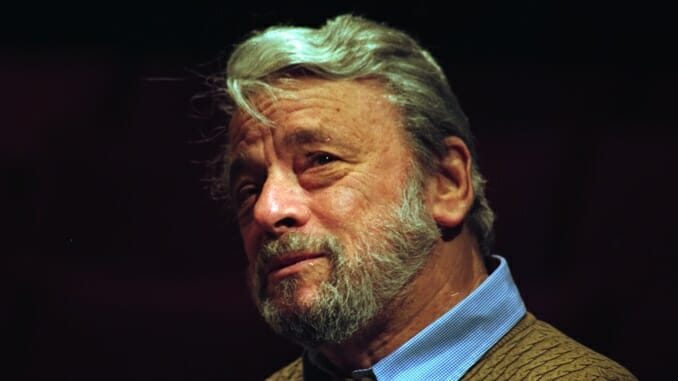Stephen Sondheim: An Unlikely Songwriter for Our Times
Photo by Douglas Elbinger/Getty
“Stephen Sondheim is possibly the best lyric writer this country has ever produced,” Randy Newman told me in 1996. “Dylan at his best may be better, but Sondheim is at his best more often. Sondheim has always written for adults. He’s a great lyricist, technically brilliant, who never condescends to his audience. A play like Passion, which I saw, is an integrated work, like a sonata form, like a movement in a symphony. Things recur. It’s like bumping into someone who has a great mind, but he can also do West Side Story.”
Sondheim, who died Friday at the age of 91, was an anomaly: a giant of the musical theater in an era when the center of gravity in American music had shifted from the stage to the pop recording studio. But such was the scale of his achievement that he couldn’t be ignored—neither inside, nor outside the insular world of Broadway. During a period when the biggest hits in musical theater came from bombastic, middlebrow merchants such as Andrew Lloyd Webber and Alain Boublil, Sondheim proved that the genre was still capable of greatness, and served as a role model for younger writers such as Lin-Manuel Miranda, Adam Guettel and Jonathan Larson.
The delightful new Netflix movie, tick, tick … BOOM! captures this passing of the torch. The film is Miranda’s debut as a director, and it tells Larson’s story through a recreation of his one-person show of the same title. This focuses on the period long before Larson died on the eve of his triumphant show Rent, on the years when the songwriter was working in a diner, struggling to pay his bills and writing musicals that few people cared about.
One person who did care was Sondheim himself. In the new movie, the bearded, slouching mensch attends the workshop read-through of Larson’s stillborn show Superbia. As played by West Wing star Bradley Whitford, Sondheim tries to slip unobtrusively into the back row of seat, but such is his force field that everyone—including Larson, played by Andrew Garfield—falls silent in awe for a moment.
And later, after a string of bad news—the producers pass on his show; his girlfriend splits—the down-and-out songwriter hears a message of encouragement from Sondheim on his phone machine, and that’s enough to make Larson light up. Miranda brings a vibrancy to these scenes, because he, too, went through such a phase. But during those lean years before In the Heights and Hamilton, Miranda kept at it, thanks in part to similar encouragement and mentoring from Sondheim.
If you know anything about musical theater at all, you understand why so many were in awe of Sondheim. It wasn’t because he was a commercial behemoth. His shows did respectably enough that someone was always willing to mount the next one, but his shows seldom ran for more than a year. And yet they keep getting revived, long after the bigger hits have been forgotten, because they’re miracles of weaving music and lyrics into a story so naturally that the songs never seem an interruption, only a shift in gears.
Sondheim got a lucky break early on. When he was 10, he met his mother’s best friend and the friend’s husband, Oscar Hammerstein, the lyricist who collaborated with Richard Rodgers on shows such as South Pacific, Oklahoma, Carousel and The King and I. Hammerstein took the teenager under his wing and taught him, Sondheim later claimed, more about writing songs for the theater than most people learn in a lifetime.
It was out of gratitude for Hammerstein’s help that Sondheim reached out to younger songwriters like Miranda, Larson and Guettel. In fact, after seeing tick, tick … BOOM! the week of his death, Sondheim messaged Miranda to say, “Thanks for the nice boost to my spirits, Lin. It’s an aspect of my life that I’m proud of. I feel as if I’ve repaid (partially at least) what I owe Oscar.”
Sondheim got a further break when he was invited to write lyrics for a musical adaptation of Shakespeare’s Romeo and Juliet, with music by Leonard Bernstein and dialogue by Arthur Laurents. That show, 1957’s West Side Story, became a classic of American theater. Bernstein and Sondheim teamed up again on another triumph, 1959’s Gypsy. Less successful was 1965’s Do I Hear a Waltz?, Sondheim’s collaboration with an aging, alcoholic Rodgers. At that point, Sondheim resolved to work only on shows where he could write both the words and the music, as he had always wanted.
To make that happen, he hooked up with director Hal Prince. The partners created five shows (with three different book writers) that are still considered musical theater masterworks: Company (1970), Follies (1971), A Little Night Music (1973), Pacific Overtures (1976) and Sweeney Todd: The Demon Barber of Fleet Street (1979).
In contrast to his mentor Hammerstein, whose wholesome optimism was a trademark of those hit shows with Rodgers, Sondheim wrote lyrics with an undercurrent of bitter irony, more like Rodgers’ earlier lyricist, Lorenz Hart. Like his words, Sondheim’s music also hinted that life didn’t always reward good intentions and fair play; the dark harmonies and twisting melodies reinforced the verbal hints that hopes are as likely to be frustrated as not. This was a very different approach to musical theater than the standard operating procedure, and made him both a heroic iconoclast and commercial risk on Broadway.
-

-

-

-

-

-

-

-

-

-

-

-

-

-

-

-

-

-

-

-

-

-

-

-

-

-

-

-

-

-

-

-

-

-

-

-

-

-

-

-








































